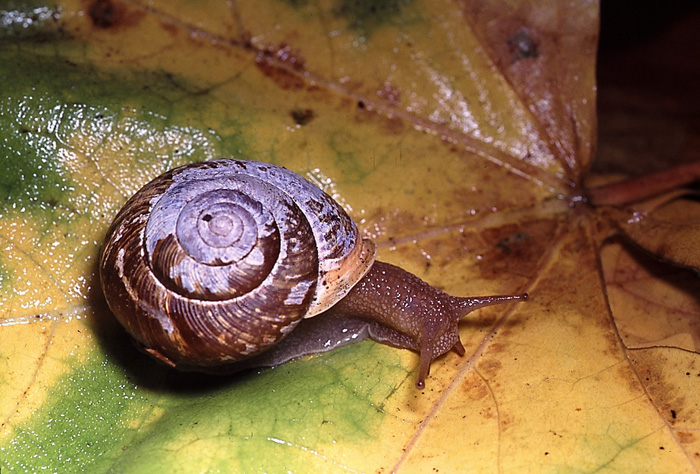
Nutrition
The diet of
Allogona townsendiana is unknown, however it is
believed that their diet is similar to that of other snails. Feeding
occurs at night when the air is more humid in order to prevent
moisture loss. For example many polygyrids are believed to be mainly
mycophagous (Pilsbry, 1939), and are
believed to eat algae as well.
 They obtain the algae by using their radula, which is a small
chitinous structure covered with tiny teeth, that is used in a
rasping manner (Hickman et al. 2009). Furthermore, a majority of Pulmonates or air-breathing snails are herbivores, but some are found to prey on earthworms and other snails (Hickman et al. 2009).
Lastly, calcium is an important component of their diet in order to
maintain their calcareous shell (Hutchins, 2003).
They obtain the algae by using their radula, which is a small
chitinous structure covered with tiny teeth, that is used in a
rasping manner (Hickman et al. 2009). Furthermore, a majority of Pulmonates or air-breathing snails are herbivores, but some are found to prey on earthworms and other snails (Hickman et al. 2009).
Lastly, calcium is an important component of their diet in order to
maintain their calcareous shell (Hutchins, 2003).
Snails are prone to water loss
through their skin and use water to produce their trail of mucus.
The pallial cavity, oesophageal crop, haemolymph, and tissue cells
hold water within the snail's body (Barker, 2001).
Snails obtain water through osmosis also known as 'contact
rehydration.' The snail absorbs water through the skin of their foot
sole while it is flattened on the wet substrate (Barker,
2001).
To locate food snails use chemoreceptors,
that can be found on their tentacles, and once they find it they
proceed to use both their mouth and foot to touch it before using
their radula (Hotopp
et al. 2006). The food then passes down their esophagus after being
partially broken down by saliva and proceeds to be further broken
down by digestive juices upon moving into the gastric pouch (Hotopp
et al. 2006). A large digestive gland connected to the gastric pouch
aids in food absorption and the excretion of wastes, which is found
in the mantle cavity (Dimitriadis, 2001).
In terms of a circulatory
system a snail’s is very well developed. Snails have an open
circulatory system with the heart located in the pericardial cavity
that has one atrium and one ventricle
(The Living World of Molluscs). In the pulmonate
Helix pomatia, a terrestrial snail, blood flows back to the lung to
be oxygenated and is nearly colorless until is re-oxygenated and
turns back to its former blue color due to the blood pigment
haemocyanin (The Living World of Molluscs).
The circulatory system is open therefore the blood flows from the
heart through the artery, then the aorta, and into the body cavity
and around the organs.
Snails are known to be
intermediate hosts of trematode parasites. Microphallus is one
example of a trematode parasite that snails contract by ingesting
the parasites eggs (King
et al. 2010). The eggs then
hatch in the snail’s gut and penetrate the snail’s tissues to reach
the gonads where they then begin to develop (King
et al. 2010). Nutrition is key for A. townsendiana and without
proper nutrients the snail would not be able to carry out
reproduction.